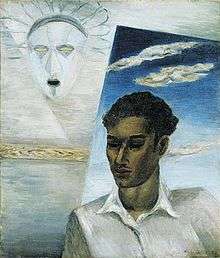Isami Doi

Isami Doi (May 12, 1903 – November 29, 1965) was an American printmaker and painter. He was the first son of Japanese immigrants, born on the island of Oahu in the Hawaiian Islands in 1903.[1] He moved with his family to the island of Kauai, and he thereafter considered Kalaheo, Kauai his home.[2]
Doi studied for two years at the University of Hawaii, went on to Columbia University for five years, and then continued his studies for a year in Paris. He stayed in New York until 1938, when he returned to the Hawaiian Islands. Doi taught printmaking, drawing, and metal work, as well as designing jewelry for the S. and S. Gumps store, a San Francisco firm that had opened a store in Honolulu in 1929, and later for Mings jewelers.[3]
His first solo show at the Honolulu Museum of Art took place in April 1929, and featured painted landscapes of the mountains of Kauai as well as fifteen prints.[4] His early works are painted in muted duns and browns, and have a discreet erotic quality. Mid-way in his career, he included symbols inherited from Greece and Rome, such as Centaurs, broken columns, and sphinxes (such as Caucasian-Hawaiian in the collection of the Hawaii State Art Museum). As his spirituality deepened, his works became closer to pure abstraction, with orange and vermilion signifying flames and light. A simplified Buddha shape is Dois hieroglyph for meditation. In his last works in the 1960s, he set aside all symbols, returning to painting the cliffs of Kauai, which he had come to view as spiritual entities. Early Spring, in the collection of the Honolulu Museum of Art, is an example of these later abstract paintings. Doi died in Kalaheo, Hawaii in 1965.
The Hawaii State Art Museum, the Honolulu Museum of Art, the Nelson-Atkins Museum of Art (Kansas City, Missouri), the Smithsonian American Art Museum (Washington, D. C.) and the University of Michigan Museum of Art (Ann Arbor, Michigan) are among the public collections holding works by Isami Doi.[5][6]
References
- Behlke, David, Isami Doi Bamboo Ridge Press, Honolulu, Issue 73, Spring 1998, pp. 41-65.
- Chang, Gordon H., Mark Dean Johnson, Paul J. Karlstrom & Sharon Spain, Asian American Art, a History, 1850-1970, Stanford University Press, ISBN 9780804757515, pp. 15, 28, 34, 102, 326, 497 & 499
- Department of Education, State of Hawaii, Artists of Hawaii, Honolulu, Department of Education, State of Hawaii, 1985, pp. 1–6.
- Doi, Isami, Excerpts from "Letters to Satoru Abe, 1952-1965" in Bamboo Ridge: Journal of Hawai'i Literature and Arts, Spring 1998, 57-64.
- Ellis, George R. and Marcia Morse, A Hawaii Treasury, Masterpieces from the Honolulu Academy of Arts, Tokyo, Asahi Shimbun, 2000, 155, 225.
- Forbes, David W., "Encounters with Paradise: Views of Hawaii and its People, 1778-1941", Honolulu Academy of Arts, 1992, 211-269.
- Haar, Francis and Neogy, Prithwish, "Artists of Hawaii: Nineteen Painters and Sculptors", University of Hawaii Press, 1974, 3-7, ISBN 0-8248-0338-8
- Morse, Marcia, Legacy: Facets of Island Modernism, Honolulu, Honolulu Academy of Arts, 2001, ISBN 978-0-937426-48-7, pp. 6, 27-45
- Morse, Marcia (ed.), Honolulu Printmakers, Honolulu, HI, Honolulu Academy of Arts, 2003, pp. 21 & 35, ISBN 0-937426-58-X
- Niiya, Brian, "Isami Doi" in Densho Encyclopedia
- Yoshihara, Lisa A., Collective Visions, 1967-1997, [Hawaii] State Foundation on Culture and the Arts, Honolulu, Hawaii, 1997, 54.
Footnotes
- ↑ Niiya, Brian. "Densho Encyclopedia: Isami Doi". Densho Encyclopedia. Retrieved 3 October 2016.
- ↑ Forbes, David W., "Encounters with Paradise", p. 268
- ↑ Forbes, David W., "Encounters with Paradise", p. 268
- ↑ Ellis, George R. and Marcia Morse, A Hawaii Treasury, p. 225
- ↑ AskArt.com accessed 8/31/11
- ↑ Smithsonian American Art Museum accessed 8/31/11